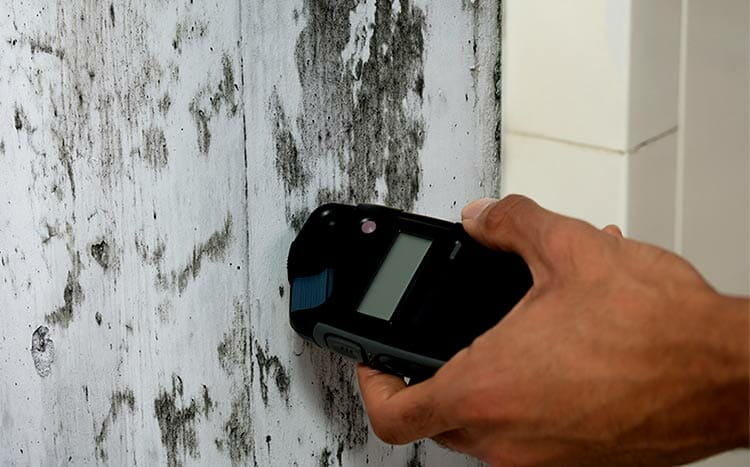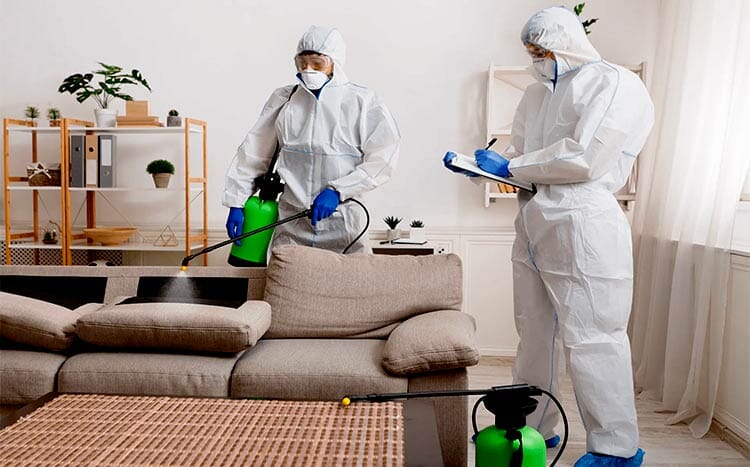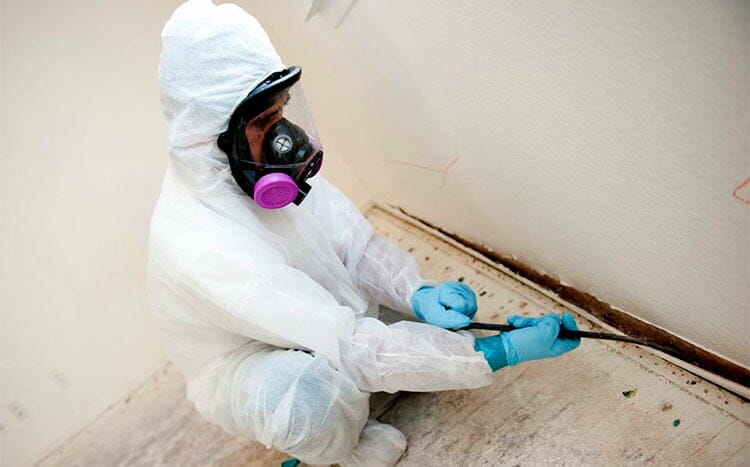Are you thinking of purchasing a new property or interested in selling one? Bam! Mold suddenly shows up during an inspection of the property. What should your next steps be?
If you are a seller, you can sell your home without removing the mold or you can choose to remove it, but, you will need to disclose the home’s mold history to prospective buyers.
As a buyer, you have the right to ask for mold history disclosure and can opt to walk away from the home if the mold problem seems to be extensive.
Here is what you should know about what you should do after the mold is found during a home inspection.

The problem with mold in a home
Mold in a home presents challenges to persons occupying the home, sellers of the home, and even buyers.
Occupants of a home with mold
When there is mold in a home, it is bad because it usually triggers allergic reactions.
It often causes eye irritation, wheezing, and nose stuffiness. Skin irritation and worsening asthma are also common symptoms.
And in severe cases, it can cause shortness of breath, fever, and blood poisoning — especially in cases where one is exposed to toxic mold.
Sellers
Selling a home with mold is challenging. This is because of the negative effects of mold exposure. And it is something that is further complicated by the fact that mold remediation and mold inspections aren’t cheap.
The following are reasons why a home with mold is a problem for sellers.
- Most buyers shy away from homes with defects. This includes homes with mold. This means that the home may take longer on the market
- Homes with mold tend to fetch lower-than-normal market prices
- If the seller decides to remediate mold before selling, then they have to budget for mold remediation expenses
- A seller will have to bear the extra burden of mold disclosure
- There is always a risk of the buyer trying to pull out of a contract down the line
Buyers
A home with mold is problematic to the buyer because:
- They will have to spend extra money to remove the mold
- Mold is often an indicator of underlying issues and so they may be taking on more risks than they are equipped to handle
- If they are buying the home with the intention of flipping it, the home’s mold history may significantly affect their potential return on investment (ROI)
- in case they are buying the property for their loved ones, then they risk exposing their loved ones to the negative effects of mold
Is it OK to buy a house with mold?
Yes, it is ok to buy a house with mold.
This is because a mold problem is a problem that is solvable. In fact, it is possible to remove the mold on your own. And given the fact that most houses with mold tend to be listed way below their market price, it is sometimes worth it.
However, you should always be aware of the risks associated with such a purchase. For example, the mold may be an indication of extensive structural issues. You may also have to spend money on mold inspection and remediation.
Should you walk away from a house with mold?
No, you shouldn’t always walk away from a house with mold. This is because mold is a fixable problem. And also because you can get a good house at a bargain just because it has mild mold problems.
A good mold remediation expert can easily kill and remove mold from the house. You can even DIY mold removal. And you will also have the option of conducting a mold inspection to make sure that mold removal has been done properly.
However, you should walk away from a house with mold in the following circumstances.
- If you are not getting a significant discount on the house
- If the house has a long history of mold that keeps coming back
- If the mold problem is a symptom of extensive structural issues
- If your bank is unwilling to lend you the amount required to buy the property, and you aren’t in a position to bear the financial burden of the purchase on your own
What happens if you buy a house and find mold?
If you buy a house and find mold, you can do any of the following.
- If you had a mold contingency clause in the contract, you can pull out of the contract. As a result, you will not have to pay the purchase price. And if you have already paid, you can go back to court to get it back.
- If the mold that you find in the home isn’t extensive, you can simply choose to remove it on your own. In such a case, you can decide to simply shoulder the cost of mold remediation on your own.
- You can also decide to pay for mold remediation, and thereafter sue the seller for reimbursement. This will be an option if the seller knew about the problem but failed to disclose it.
How much does mold affect home value?
Mold presence devalues a property by more than 3% even in cases where the property has been properly remediated. In some cases, especially in cases where the house is sold as-is, it can slash the value of the house by up to 50%.
At the minimum,
However, how much the property mold affects a property’s value depends on the location of the property, the extent of the mold infestation, and the overall market landscape — in terms of the availability of competing properties.

Cost of mold inspection
Mold inspection costs vary depending on the area that has to be inspected. Things like location, the qualifications of the person conducting the inspection, and the mold inspection service provider, also play a role in determining how much it costs.
If you suspect mold, most mold remediation companies will give you a free mold inspection to determine the extent of the infestation and give you a free estimate to do the job.
Here is a breakdown of the typical costs of mold inspections.
| Cost Item | Amount in $ |
|---|---|
| The typical range of mold inspection cost | $450 - $400 |
| Average mold inspection cost | $650 |
| High-end cost of mold inspection | $1000 |
| Low-end cost of mold inspection | $300 |
Common mold problem areas in a home
The following are the most common mold problem areas in a home.
- The basement especially when it is crowded, poorly ventilated, or flooded
- Behind wallpapers in bathrooms and kitchens
- Under bathroom sinks
- Bathroom tile grout
- Around shower heads and faucets
- Shower curtains
- HVAC vents
- Chimneys and fireplaces
- Upholstery and fabric
- Window sills
How do you detect mold in a home?
You can detect mold in a home in the following ways.
Smell
Mold has a musty smell. Therefore, if this smell is prevalent in your home, chances are that there is mold in the home.
Discoloration
Mold can be grey, white, black, green, purple, yellow, or brown. As a result, they tend to create ugly marks on surfaces that they attack. You can thus detect them by looking for ugly discolorations on wet or moist surfaces.
In case you are not sure whether the discoloration is a result of dirt or mold, you can always apply diluted bleach to the discolored area. If it turns white, then a mold is to blame for ugly markings.
A mold inspection
An inspection that is conducted by a professional mold inspector can identify pockets of mold growths.
How do you protect yourself against mold-related risks when buying a home?
You can protect yourself against mold-related risks by:
- Including mold contingencies in the agreement of sale
- Hiring a professional to conduct an extensive mold inspection before buying the property
- Seeking a steep discount that will help to soften the financial blow in case the mold problem turns out to be worse than it seemed
How much does it cost to remove mold that was found in a home inspection?
On average, the cost of removing mold found after a home inspection ranges between $1500 to $3,500. However, the actual amount that a homeowner pays can be as low as $500 or as high as $7000.
It all depends on the size of the area from which mold has to be removed, the location of the mold, and the homeowner’s choice of mold remediation services provider.
FAQ's
Since a home inspector evaluates a home’s condition with the aim of identifying potential and immediate problems, they will likely check for and point out obvious signs of mold. They can also identify the possible causes of the problems and give an estimation of how extensive the mold infestation is.
However, home inspectors do not carry out detailed and exhaustive mold inspections. This is something that qualified mold inspectors do. Therefore, if you want a detailed mold report on your property, then opting for a mold expert is advisable.
Yes, you can sell a home with mold. You can sell it as it — with the mold. Or you can remove the mold first before selling it. Whichever option you choose, you have an obligation to disclose mold problems to the buyer. This includes past mold problems.
When mold is discovered in a home, you should start off by identifying the source of the mold problem. Is it a roof leak? Is it a problem with basement flooding? Or does it have anything to do with a leaking air conditioning unit?
After identifying the problem, you should fix it. And it is only after fixing the underlying problem should you then seek to kill and remove it.
To kill and remove the mold, start by first cleaning the area. Vacuum it. And then apply a mold-killing solution to the affected area. This can be undiluted white vinegar, diluted bleach, baking soda, or even alcohol. Thereafter, dry the area.
If you don’t want to DIY the mold removal process, you can simply hire a professional mold remediation expert.
You kill mold by using a mold-killing solution. Vinegar, baking soda, bleach, and other home products that have antifungal properties are generally good at killing mold.
You can also kill mold by spraying it with commercial mold-killing solutions. These solutions can come as ready-to-use sprays. Some come as concentrated liquids that need to be diluted before use.







